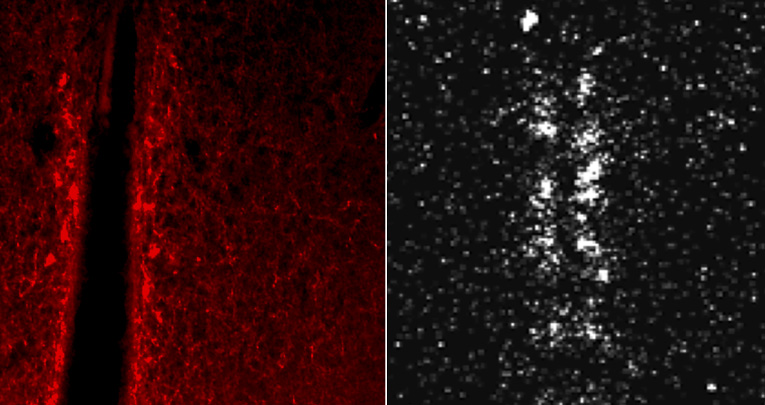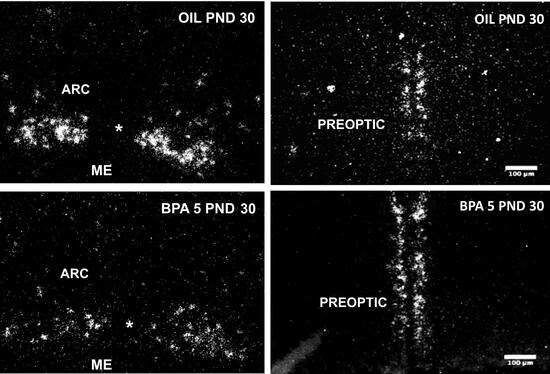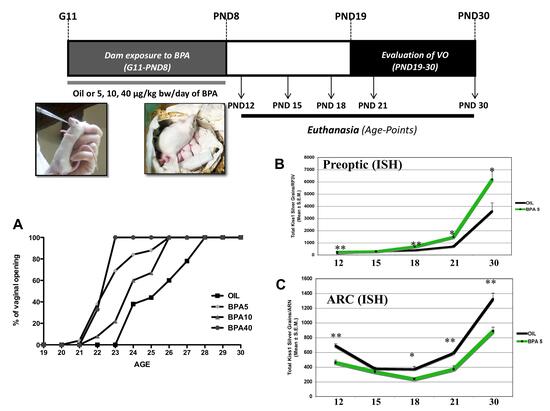
Environmental Health Perspectives
, October 2019
Environmentally Relevant Perinatal Exposures to Bisphenol A Disrupt Postnatal Kiss1/NKB Neuronal Maturation and Puberty Onset in Female Mice
.
Ruiz-Pino F 1,2,3 , Miceli D 4,5 , Franssen D 1,2,3 , Vazquez MJ 1,2,3 , Farinetti A 4,5 , Castellano JM 1,2,3 , Panzica G 4,5 , Tena-Sempere M 1,2,3
BACKGROUND
The timing of puberty is highly sensitive to environmental factors, including endocrine disruptors. Among them, bisphenol A (BPA) has been previously analyzed as potential modifier of puberty. Yet, disparate results have been reported, with BPA advancing, delaying, or being neutral in its effects on puberty onset. Likewise, mechanistic analyses addressing the central and peripheral actions/targets of BPA at puberty remain incomplete and conflictive.
OBJECTIVE
We aimed to provide a comprehensive characterization of the impact of early BPA exposures, especially at low, real-life doses, on the postnatal development of hypothalamic Kiss1/NKB neurons, and its functional consequences on female pubertal maturation.
METHODS
Pregnant CD1 female mice were orally administered BPA at 5, 10, or 40μg/kg body weight (BW)/d from gestational day 11 to postnatal day 8 (PND8). Vaginal opening, as an external marker of puberty onset, was monitored daily from PND19 to PND30 in the female offspring. Blood and brain samples were collected at PND12, 15, 18, 21, and 30 for measuring circulating levels of gonadotropins and analyzing the hypothalamic expression of Kiss1/kisspeptin and NKB.
RESULTS
Perinatal exposure to BPA, in a range of doses largely below the no observed adverse effect level (NOAEL; 5mg/kg BW/d, according to the FDA), was associated with pubertal differences in the female progeny compared with those exposed to vehicle alone, with an earlier age of vaginal opening but consistently lower levels of circulating luteinizing hormone. Mice treated with BPA exhibited a persistent, but divergent, impairment of Kiss1 neuronal maturation, with more kisspeptin cells in the rostral (RP3V) hypothalamus but consistently fewer kisspeptin neurons in the arcuate nucleus (ARC). Detailed quantitative analysis of the ARC population, essential for pubertal development, revealed that mice treated with BPA had persistently lower Kiss1 expression during (pre)pubertal maturation, which was associated with lower Tac2 (encoding NKB) levels, even at low doses (5μg/kg BW/d), in the range of the tolerable daily intake (TDI), recently updated by the European Food Safety Authority.
CONCLUSIONS
Our data attest to the consistent, but divergent, effects of gestational exposures to low concentrations of BPA, via the oral route, on phenotypic and neuroendocrine markers of puberty in female mice, with an unambiguous impact on the developmental maturation not only of Kiss1, but also of the NKB system, both essential regulators of puberty onset.
In situ hybridization for Kiss1 mRNA in female from control mothers (OIL) or treated with BPA. It is possible to appreciate the inverse effect of perinatal exposure to BPA in the two considered regions. In the arcuate nucleus (ARC) there is a decrease in mRNA expression, while in the preoptic region there is an increase.
Graphical abstract









